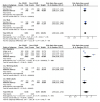Effect of COVID-19 Pandemic on Influenza Vaccination Intention: A Meta-Analysis and Systematic Review
- PMID: 35455354
- PMCID: PMC9026798
- DOI: 10.3390/vaccines10040606
Effect of COVID-19 Pandemic on Influenza Vaccination Intention: A Meta-Analysis and Systematic Review
Abstract
Poorer outcomes have been reported with COVID-19 and influenza coinfections. As the COVID-19 pandemic rages on, protection against influenza by vaccination is becoming increasingly important. This study examines how COVID-19 has influenced influenza vaccination intentions from a global perspective. A literature search was conducted on Embase, PubMed, and CNKI from 1 January 2019 to 31 December 2021 for articles reporting rates of influenza vaccination pre-COVID-19 (19/20 season), and intention and/or uptake of influenza vaccination post-COVID-19 (20/21 season). The changes in vaccination intention and reasons for changes were reported. Subgroup analyses were performed by region, gender, age, and occupation. Newcastle Ottawa Scale was used for quality assessment of the articles. Twenty-seven studies with 39,193 participants were included. Among 22 studies reporting intention to vaccinate in 20/21, there was increased intention to vaccinate (RR 1.50, 95% CI 1.32−1.69, p < 0.001) regardless of age, gender, and occupation. The remaining five studies reporting vaccination intention and uptake in 20/21 showed a similar increase (RR 1.68, 95%CI 1.20−2.36). Important determinants include historical vaccine acceptance, and perception of influenza severity and vaccine safety. The COVID-19 pandemic has increased intention to vaccinate against influenza internationally. The pandemic could be a window of opportunity to promote influenza vaccination and decrease vaccine hesitancy.
Keywords: COVID-19; influenza; meta-analysis; vaccination; vaccine hesitancy.
Conflict of interest statement
The authors declare no conflict of interest.
Figures





References
-
- World Health Organization Top Ten Causes of Death. [(accessed on 7 August 2021)]. Available online: https://www.who.int/news-room/fact-sheets/detail/the-top-10-causes-of-death.
-
- Paget J., Spreeuwenberg P., Charu V., Taylor R.J., Iuliano A.D., Bresee J., Simonsen L., Viboud C. Global mortality associated with seasonal influenza epidemics: New burden estimates and predictors from the GLaMOR Project. J. Glob. Health. 2019;9:020421. doi: 10.7189/jogh.09.020421. - DOI - PMC - PubMed
-
- Chow E.J., Rolfes M.A., O’Halloran A., Anderson E.J., Bennett N.M., Billing L., Chai S., Dufort E., Herlihy R., Kim S. Acute cardiovascular events associated with influenza in hospitalized adults: A cross-sectional study. Ann. Intern. Med. 2020;173:605–613. doi: 10.7326/M20-1509. - DOI - PMC - PubMed
-
- Iuliano A.D., Roguski K.M., Chang H.H., Muscatello D.J., Palekar R., Tempia S., Cohen C., Gran J.M., Schanzer D., Cowling B.J. Estimates of global seasonal influenza-associated respiratory mortality: A modelling study. Lancet. 2018;391:1285–1300. doi: 10.1016/S0140-6736(17)33293-2. - DOI - PMC - PubMed
Publication types
LinkOut - more resources
Full Text Sources
Research Materials

